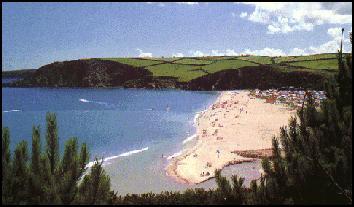
The Heritage Trail will rarely take you far from the beauty of St. Austell Bay. For many visitors the Bay's sandy beaches; smuggler's coves; miniature harbours and sea-carved cliffs are enough - yet there is more, much more be discovered here.
The Heritage Trail includes attractions which illustrate the region's rich and colourful past and explains many of its present day activities. Follow the Trail and history will come alive for you in surroundings to delight all who have time to pause awhile and enjoy what is on offer.
From the museum in that delightful and ancient assay town of Lostwithiel, travel to St. Stephen. Here, in Automobilia, view many fine examples of the vehicle that has revolutionised all our lives.
Walk the beautiful valley of Luxulyan, dominated by the magnificent viaduct built by Joseph Treffry. Discover for yourself traces of an industry that once provided employment for thousands in these attractive woodlands. In the Luxulyan museum are relics of years of man's endeavours in this secluded place.
Travel on to Fowey and pay a call on another fascinating museum. Outside, pause to enjoy the harbour. Cornishmen will tell you this is the most beautiful in the land. From this yachtsman's paradise ships carry cargoes of China Clay to the industrial centres of the world.
Another small harbour between Fowey and St. Austell is Polkerris which has a lime kiln on the curved quay which was built by Philip Rashleigh, in the late 18th century, to burn limestone and produce lime for conditioning the soil for local farmers. Now a picturesque place to spend time relaxing.
Between Par and Fowey is the charming, and unusually verdant, Gribbin Head with its red and white striped beacon built in 1832 and commanding views of the adjoining coastline. This headland provides a prominent landmark for walkers on the coastpath.
Around the fringes of St. Austell Bay many fine ships have been wrecked. Learn something of them in the Charlestown Shipwreck Centre. While you are here buy a souvenir that might have lain in the hold of a decaying ship for more than two centuries.
Nearby is Charlestown, built by Charles Rashleigh and is one of the smallest harbours in the country. If you are fortunate you may find a ship moored here that took part in one of your favourite period television series, as it is now used by the tall ships.
Staying with the sea, visit Mevagissey's Museum, tucked away on the quayside of this working fishing port. Mevagissey's narrow alleyways, and low, overhanging eaves have foiled many a press gang and revenue officer.
The sea around the bay provides a never-failing source of interest and enjoyment, but turn your back upon it for a while. A few miles inland, at Ruddlemoor, in the shadow of the Clay "mountains discover the reason why man has changed the skyline of the country hereabouts. At the Wheal Martyn Museum learn the secrets of winning China Clay from the ground, or take a tour from here with the 'Cornwall of Mine', and follow the progress of China Clay through its many processes to the final product, used in a wide variety of everyday commodities.
This is the industry which took over from tin mining. The story of the discovery and exploitation of China Clay by William Cookworthy in 1768 is as romantic, in its own way, as that of the age old industry it replaced. Harbours at Par and Pentewan became very busy places shipping thousands of tons of clay over the years.
What better place to end your tour of discovery than St. Austell Brewery, stockists of fine wines and makers of a truly Cornish brew for almost 150 years.
Whatever your interests, no matter how varied your tastes, you will satisfy them on the St. Austell Bay Heritage Trail.
You will also leave Cornwall with a better understanding of the area and all it has to offer. If you do not have time to take it all in.......... well, there is always next year!
Charlestown St. Austell Fowey Polkerris Lostwithiel Par Pentewan Porthpean Mevagissey
The Clay Trails The Eden Project The Lost Gardens of Heligan St. Austell Town Museum